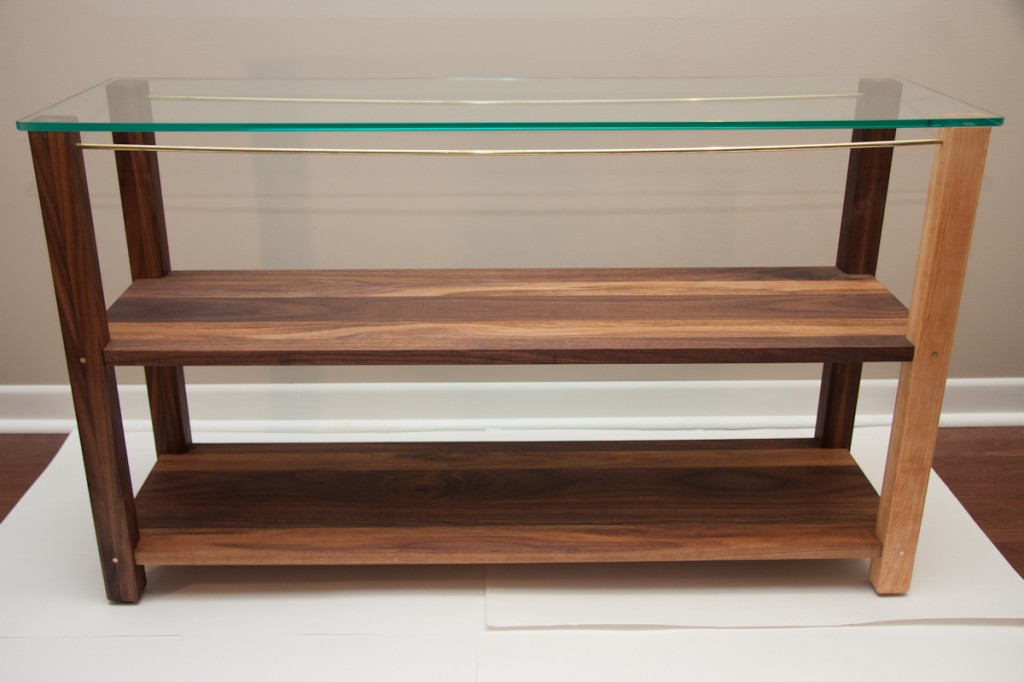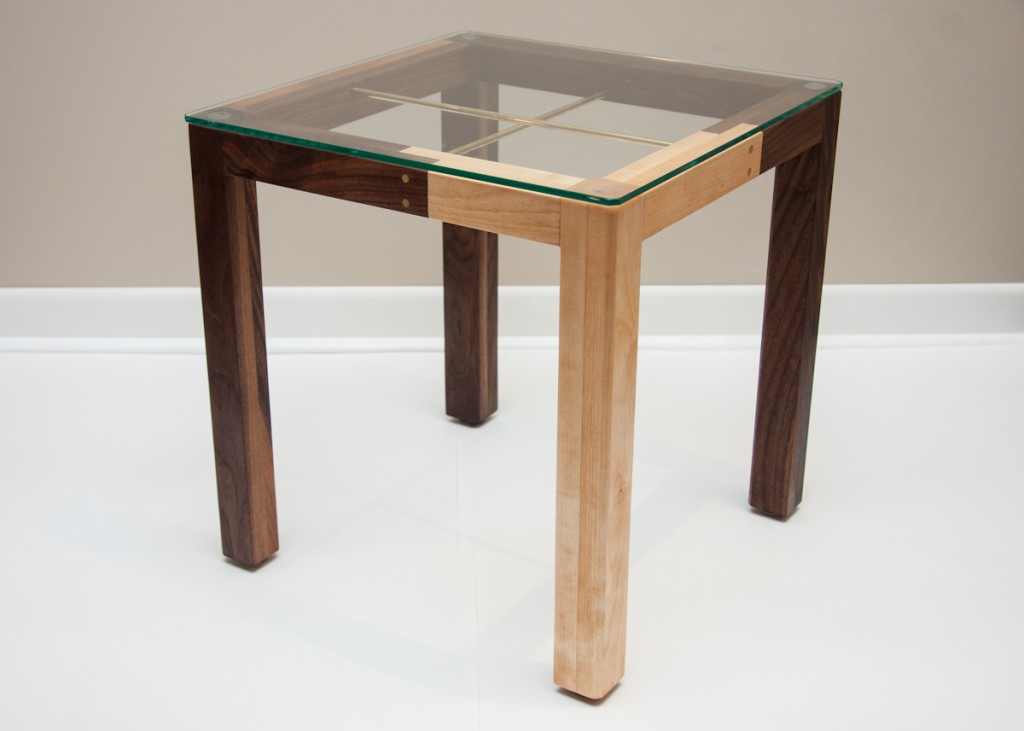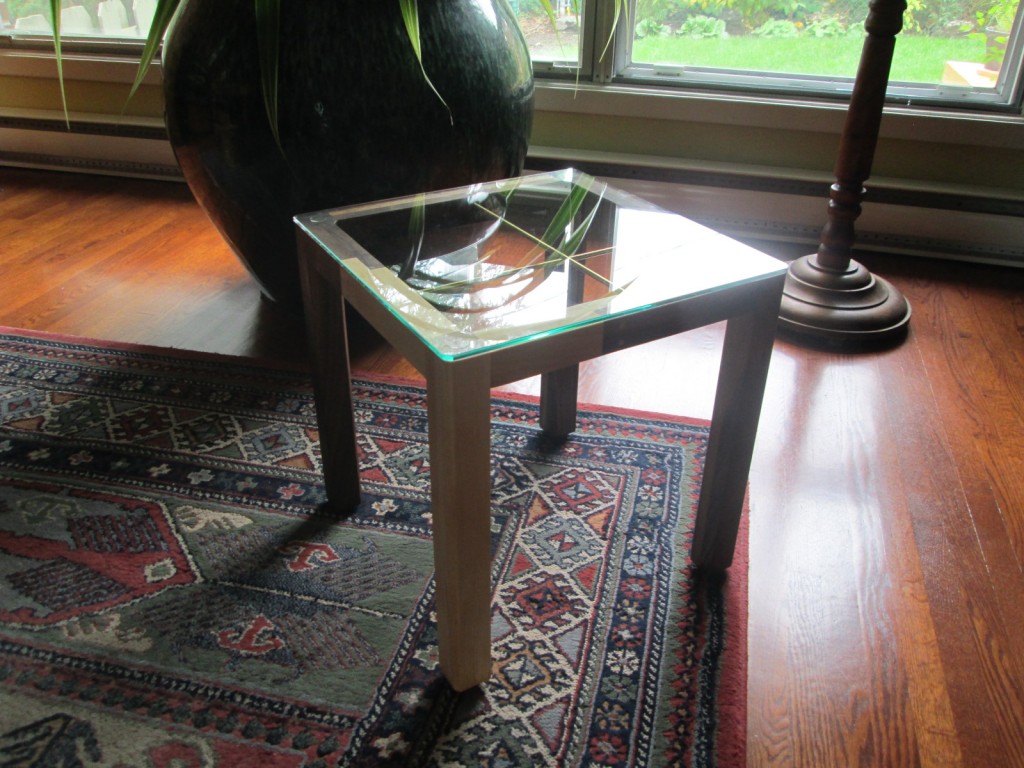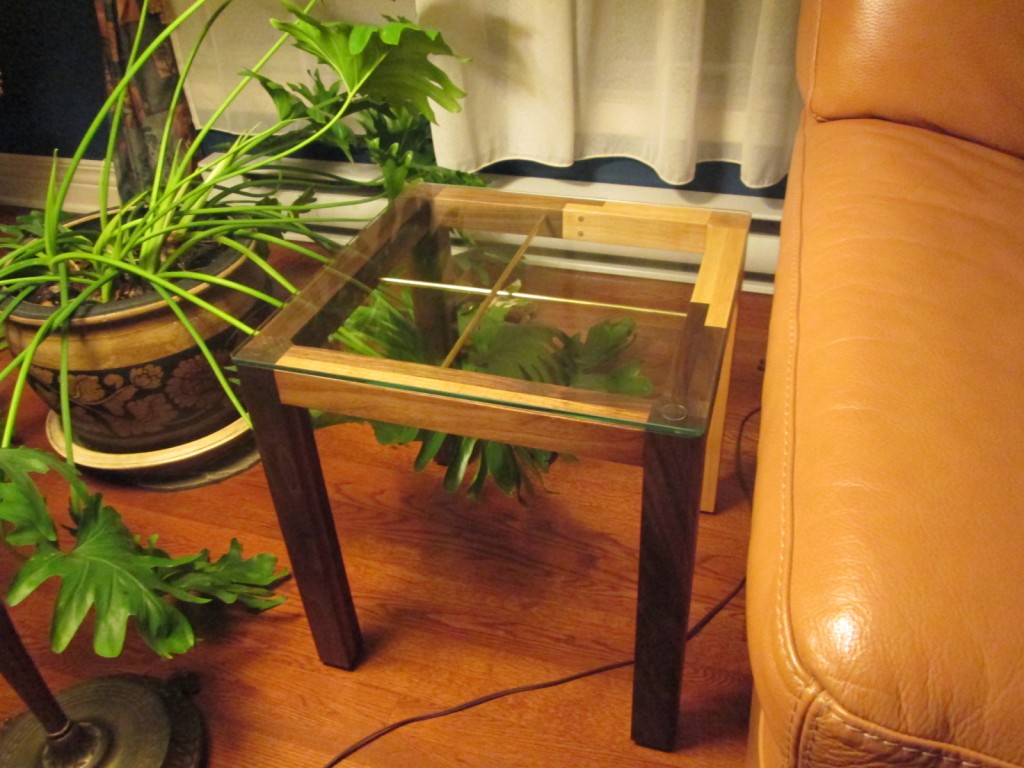A table made to compliment my coffee table and two side tables. The top is a 10mm thick pane of glass and most of the table is made out of walnut except for one leg, which is made from maple. Just for the looks, I added brass inserts and rods, but everything is held together using dowels.
The mutants: walnut/maple/birch side tables
Two side-tables made out of walnut and maple or yellow birch and finished with danish oil. The top is glass and they both feature brass inserts and rods. These additions hold no structural responsibility, everything was attached using dowels.
The pair got their name from the fact that they are mainly crafted from walnut, but each feature one leg made of a lighter-colored wood joined as it the table was mutating. They are of a very similar design to this project and this other one because they were made to compliment them.
Cutting boards from a stair step – getting fancier
I’ve been ordered more cutting boards using the same process described here except this time, I’ve gone fancier with shapes and materials. They still are mostly made from maple (from a stair step), but I’ve added rows of cherry and walnut and one even has brass inserts (not on the cutting surface).
Cutting boards from a stair step
Cutting boards are sort of the “hello world” of woodworking. Nearly every hobbyist’s first few projects will at least involve the building of one and I was no exception. Since they unanimously make such great gifts, are quick to make and can be batched out easily, you always end up making a few once in a while for occasions where present giving is expected. You can get absolutely crazy with end-grain cutting boards pattern (google it), but frankly, the simplest layout will expose the beauty of the wood in a way that is guaranteed to please everyone.

I found out not too long ago that the process can be made a lot cheaper and faster by recycling stair steps easily found in any scrap wood pile at relevant shops where they make custom staircases. Occasionally, they will put the wrong finish on a set of steps and instead of tossing it, they will plane it one more time and sell it as scrap because it no longer has the required thickness. The steps that I got were 10$ a piece and made of maple, but I suspect one could get them in all sorts of varieties. Worst comes to worst, you can probably buy them new and unfinished and it will probably not be that much more expensive considering you are getting nice wood and that part of the gluing-up is done for you.

Afterwards, the process to transform them into cutting boards is as trivial as cutting them to lengths and softening the edges but if you want and end-grain cutting board as opposed to edge grain, that is a board on which the actual growth rings are visible on the cutting surface (looks nicer and easier on the knives), there is a bit more work involved. The steps have to be cut down in slices, rotated 90 degrees to expose the end-grain and then glued-up this way. Then comes the more complicated part.

If your tools are as execrable as mine, chances are the dried-up result will be all crooked and encrusted with glue. No need to panic, find the flattest side and work at it using a belt sander (or elbow oil if that is all you have) until reasonable flatness is achieved. Then, if you own a drum sander or have access to one, send it through a couple times on each side and you should end up with something that resembles a kitchen accessory. If you do not own a drum sander, you can use a planer but in doing so, be extremely careful to make your planing increments as small as possible. Planer are not meant to cut perpendicular to the grain, it will be hard on them and will cause massive tear-out, be prepared to glue sacrificial wood or cut up what has been messed up. Overdo it a tiny bit and you might split the board in half (like it happened to me), ruin you planer in a spectacular explosion of metal and plastic shrapnels and/or send the board back the way it came in at supersonic speed. There is a bunch of horror stories on forums.

Next comes the sanding of the cutting surface and the edges but before that, decorations should be added to make the board stand apart from the ones you can get at Ikea. It can be a nice bevel, and asymmetric cut, handles, or like I did, inserts using a different type of wood.
Finally, seal the board by wiping a couple times it with your favorite product. What I had handy was heavy mineral oil but I know other solutions exist on the market. Sealing is primordial as it will prevent any organic matter into getting inside the board, rotting and contaminating food down the road. This is especially important with end-grain cutting board as end-grain, having been evolved by nature to conduct sap up the trunk to the leaves, is very absorbent and efficient at conducting liquids. So much so that completely saturating it with oil might take a few passes over some days, once every use for a week, once a week for a month, monthly for a year and then as needed. You will know when the board is saturated when the board stops absorbing the oil altogether and see drips on the underside. Better finishes do exist, such as a mix of paraffin and oil, food-safe vanishes, etc, google them or check this very instructing video by the Wood Whisperer.
Enjoy the giving of a gift anyone will appreciate and do make it a requirement that you will come over to their place for a meal in exchange. Buying something for someone is nice but thankfully, most can still appreciate the much higher value of a present that was hand-made.
Central America – The end

From Utila, Honduras to Caye Caulker, Belize
I’ll admit that as soon as my plane ticket was bought, I sort of checked out and turned on the autopilot. I’m glad my brain did that on my behalf, because the journey was a grueling one. Numerous chicken buses, border crossings, a boat; it took two days and a half to get there. To make things a bit faster (but more complicated), we even went through Guatemala. The reason I just pushed through was that I wanted to dive the Blue Hole in Belize, some cenotes as well, and meet a friend on Isla Mujeres. That’s too bad because what the Lonely Planet said about Belize is true, it vibrates to a different tune than the rest of Central America. It is friendly, clean and boasts well preserved nature as well as loads of mayan ruins. It is well worth spending come time in but I had to press on.
The Blue Hole did not live up to its reputation and that I expected. Many people back in Utila had told me just that but I still enjoyed it since I had never ever done a dive that special and got to see sharks for the very first time as well. Otherwise, it was just a big, deep, dark, blue hole; like seeing the Eiffel tower is a must on a trip to Paris, the Blue Hole has to be dived on a trip to Belize. The two other dives afterwards were interesting and considered by most the highlight of the tour, but for me, swimming at 41 meters deep between stalactites with sharks watching us from far off into the hole is what made my day.
From Caye Caulker, Belize to Tulum, Mexico
A solid day of travelling later and I had reached my second stop, Tulum. Compared to the rest of Central America, going places on the Yucatan peninsula was a piece of cake: no chicken buses, plenty of departues and reliable services. Tulum is a popular destination, praised for its beaches and the many activities you can do around. After all it sits just at the edge of the Cancun region, a resort paradise. But beside a quick trip to the local Mayan ruins, I was not there for that, I was there for diving the cenotes.
Consider world-class diving sites, the cenotes are simply big sink holes in the jungle. As a side note, the Blue Hole is also a cenote, it just sits completely underwater now but it was formed in the same fashion before the level of the seas started raising. Little life is to be found in there, blindfishes, shrimps, small isopods, the cenotes are not popular for their fauna and flora. They are famous for their rock formations, the lighting effects you can see under the right conditions, and cave diving in general. The Yucatan peninsula lies over a huge network of underwater rivers of which the extent is not very well known, but every time a cenote opens up on the surface, a new access to that labyrinth is created. You can enter through one and come up another a few kilometers away, but that is serious cave diving and done by very few highly trained people; if you get lost, you die. I am not that crazy yet, but I feel that if I keep subjecting myself to compressed air at depth, I could get that mad eventually.

Crystal clear water, infinite visibility, no currents, mind-blowing rock formation and being deep enough in a cavern not to be able to see the light of day make for an out of this world experience. However, the highlight of my diving there was not swimming between millions of year old limestone columns, but going down the pit, where two very impressive natural phenomenons can be witnessed: a sulfur cloud and a halocline. The sulfur cloud lies at the bottom of the pit and is the result of vegetation that has fallen down to the bottom slowly decomposing in the water. Everyone is accustomed to seeing clouds in air, but water being a different fluid, their formation takes in a different shape, especially when it is perfectly immobile. From a distance, the result is layered perfectly even and opaque clouds, as you close up, fluid dynamics patterns start emerging, disrupt (it take a few days to reform) the cloud by passing your hand through and create some more, move your flashlight around at the same time and you are in for a trip. The halocline is not as impressive but provides for another interesting effect on the way up. It is the interface between salt and fresh water and because the two have different densities they do not mix. Well, only across their fuzzy boundary, which has a varying refraction index and consequently distorts light traversing the layer that you just pass through going down but actually swim in going up (as part of the dive), making everything look blurry. A similar effect happens between cold and hot water called a thermocline, but the difference in density not being as high, the blurriness is a lot more subtle. With the halocline, you vision is severely impaired, everything you see takes the appearance of a painting from the impressionists and if it was not for the flashlight of the guide, I would have totally lost him. Best dive ever. Here are links to two images from the cenotes I dove in (they are not my own so I cannot post them here), one is from dos ojos cenote and the other is from the pit.
From Tulum to Cancun, Mexico
Initially, the only reasons I departed from Cancun was because I wanted to dive the cenotes and because the plane tickets were cheap. Back in Utila tough, I befriended Rodrigo, who worked as a dive master at Isla Mujeres, an island a couple kilometers off of Cancun, so I decided to shorten my overall way up to meet him over there.
I did two dives with him around the island which were fine, apart for the insane currents on the first one, but the highlight was supposed to be a wreck the next day, which got cancelled because the two other idiots had partied too much the night before. I was hangover myself and still showed up because I knew that operations like this need a minimum amount of people to justify going out, but apparently they did not and decided to sleep in. Quite frustrating. My plane was leaving the next day early in the morning (as usual, I slept at the terminal) so I could not dive in the afternoon and was stuck killing a full day’s worth of time on the island, which is extremely touristic. After 4 months of travelling and being so close to the end, I was not in the mood to enjoy it, all I wanted was to get home.
This is it. That was the end of this Central America trip.










